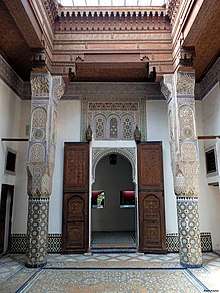Dar Jamai Museum
The Dar Jamai Museum (also spelled Dar Jamaï or Dar Jama'i) is a museum in Meknes, Morocco. It displays a number of artifacts and art objects from the city and other regions in Morocco. It is housed in a late 19th-century palace built by the Jama'i family who also built the Jamai Palace in Fes.

History
The palace was built in 1882 by Mokhtar ben Arbi el Jama'i, who, along with his brother, served as Grand Vizier under Sultan Moulay Hassan (ruled 1873–1894).[1][2][3][4][5] His family also built the Jamai Palace in Fes.[3] When Moulay Hassan died in 1894, his younger son Moulay Abdelaziz was installed on the throne with the help of Ba Ahmed, one of the Jama'i family's rivals. The family thus fell out of favour and saw much of their assests, including the palace, confiscated.[6][7][4] The palace was then given to the Glaoui family.[5] In 1912, upon the advent of French colonial rule over Morocco, it was taken over by the French and turned first into a military hospital, then a military court, and finally, in 1920, into a "Museum of Indigenous Arts" (meaning local Moroccan art objects).[1][5]
Architecture
The palace covers a relatively large area at the northern edge of el-Hedim Square in the old city. It is designed according to traditional Moroccan architecture, decorated with sculpted and painted wood, carved stucco, and colourful zellij mosaic tilework. In addition to various rooms on multiple floors, it contains a large courtyard garden (riad) with orange trees and a menzeh (observation pavilion or platform).[1][5][2][4] The palace also had other facilities including kitchens, a mosque, and a small hammam (bathhouse).[1][4] An old upstairs reception room or salon with rich decoration and a wooden cupola ceiling has also been outfitted with traditional upper-class furnishings and is considered one of the highlights of the museum.[2][5][1] Outside the palace is a large street fountain facing Place el-Hedim, adjoined to the exterior of wall of the palace. The current entrance, next to this fountain, was created recently and replaces the original entrance which was off a nearby street.[4]
Museum collection
The museum holds a variety of artifacts from Meknes and the surrounding region, including ceramics, wooden objects, embroidery, carpets, and jewellery.[5][1] Most objects date from the 19th or 20th centuries, but some older objects date from the reign of Moulay Isma'il or earlier.[2] Among the latter are the wooden minbar and maqsura of the Lalla Aouda Mosque, dating from the late 17th century when Moulay Isma'il built the mosque.[8]
Gallery
.jpg) Large street fountain on the exterior wall of the palace, facing Place el-Hedim
Large street fountain on the exterior wall of the palace, facing Place el-Hedim View of the fountain and trees in the courtyard garden of the palace
View of the fountain and trees in the courtyard garden of the palace A fountain and menzeh (observation pavilion) in the courtyard garden of the palace
A fountain and menzeh (observation pavilion) in the courtyard garden of the palace Doorways and rooms of the palace
Doorways and rooms of the palace The restored upstairs salon
The restored upstairs salon The wooden cupola above the restored upstairs salon
The wooden cupola above the restored upstairs salon The late 17th-century minbar of the Lalla Aouda Mosque, on display at the museum
The late 17th-century minbar of the Lalla Aouda Mosque, on display at the museum
References
| Wikimedia Commons has media related to Dar Jamai, Meknes. |
- "Dar Jamaï Museum". Discover Islamic Art - Virtual Museum. Retrieved 2020-08-04.
- The Rough Guide to Morocco (12th ed.). Rough Guides. 2019. pp. 194–195.
- Parker, Richard (1981). A practical guide to Islamic Monuments in Morocco. Charlottesville, VA: The Baraka Press.
- Touri, Abdelaziz; Benaboud, Mhammad; Boujibar El-Khatib, Naïma; Lakhdar, Kamal; Mezzine, Mohamed (2010). Le Maroc andalou : à la découverte d'un art de vivre (2 ed.). Ministère des Affaires Culturelles du Royaume du Maroc & Museum With No Frontiers. ISBN 978-3902782311.
- "Dar Jamaï Museum | Meknes, Morocco Attractions". Lonely Planet. Retrieved 2020-08-15.
- Burke, Edmund (2009). Prelude to Protectorate in Morocco: Pre-Colonial Protest and Resistance, 1860–1912. University of Chicago Press. p. 41.
- Pennell, C.R. (2000). Morocco Since 1830: A History. New York University Press. p. 108.
- El Khammar, Abdeltif (2017). "La mosquée de Lālla ʿAwda à Meknès: Histoire, architecture et mobilier en bois". Hespéris-Tamuda. LII (3): 255–275.